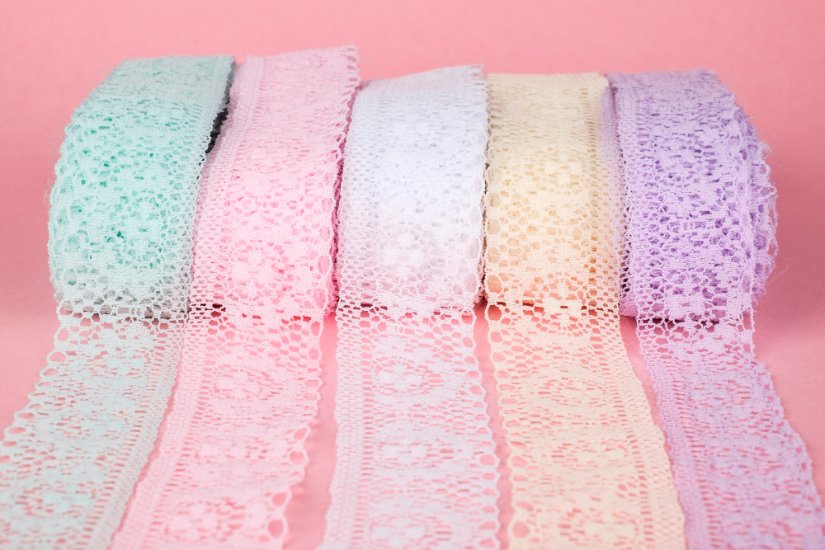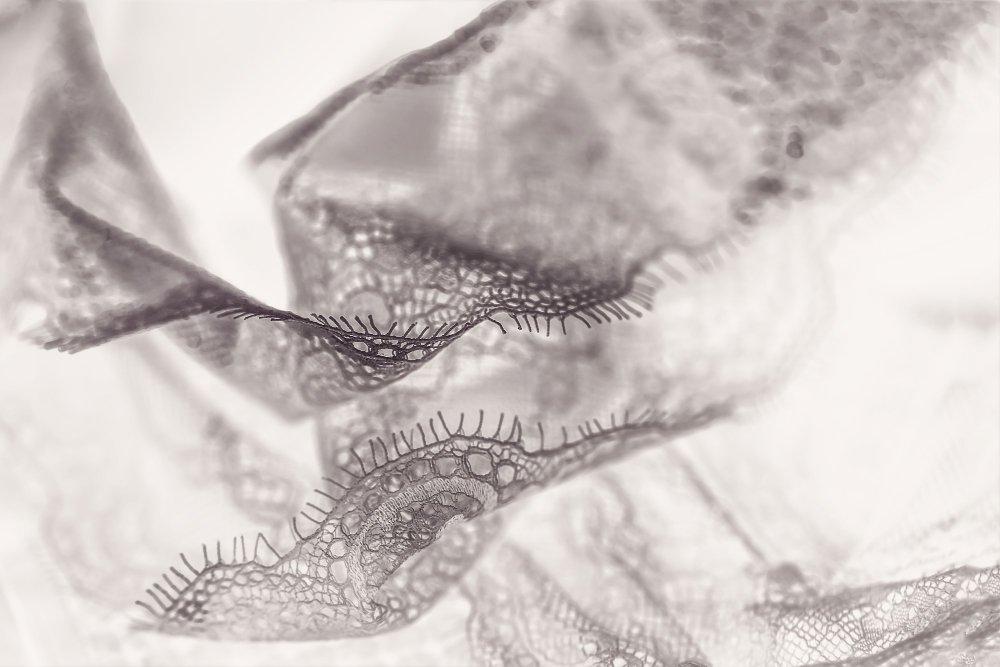Learn everything you need to know about bobbin lace making, from basic techniques to advanced projects
Did you know a single piece of bobbin lace can involve over 200 threads manipulated at once? This centuries-old textile art, once called “bone lace” for its early ivory tools, now fuels modern creativity with its intricate patterns and timeless appeal.
Unlike mass-produced alternatives, handmade versions showcase unmatched detail through braided threads wound on specialized spools. Crafters across generations have transformed simple materials into delicate collars, elegant table runners, and even contemporary wall art using this method.
Today’s makers blend traditional techniques with bold colors and unexpected materials. The results? Unique jewelry, mixed-media installations, and personalized garment accents that honor history while pushing creative boundaries.
Table of Contents
Quick Start Guide: Can You Learn Bobbin Lace at Home?
Yes, you absolutely can learn bobbin lace at home! While it looks intimidating, bobbin lace is basically an elaborate braiding technique worked around carefully placed pins. If you’ve made friendship bracelets, macrame, or even done basic sewing, you already have transferable skills.
What You Need to Get Started
- Time investment: 16+ hours for your first simple bookmark
- Initial cost: $50-150 for basics (or $15 with DIY alternatives)
- Space required: A table or lap area with good lighting
- Learning curve: Most people grasp basics within 2-3 practice sessions
Your First 30 Minutes
- Watch a basic tutorial on YouTube (search “cloth stitch bobbin lace”)
- Practice the two fundamental movements: cross-twist-cross (whole stitch) and cross-twist (half stitch)
- Use clothes pins as temporary bobbins with thick yarn to see the pattern develop
- Don’t worry about perfection – your first attempts will have mistakes, and that’s completely normal
Understanding Bobbin Lace: What Makes It Special?

What Is Bobbin Lace?
Bobbin lace is a lace fabric created by braiding and twisting multiple threads that are wound on small spools called bobbins. As you work, pins hold the developing pattern in place on a padded pillow, creating openwork designs that can be incredibly intricate.
Is Bobbin Lace Handmade?
Traditional bobbin lace is always handmade, which is what makes it so special. Each piece represents hours of careful manipulation of individual threads. While machines can create lace-like fabrics, they cannot replicate the unique characteristics and slight variations that make handmade bobbin lace so beautiful.
How Old Is Bobbin Lace?
Bobbin lace originated in 16th-century Italy, with the first documented reference appearing in a 1493 legal document from Milan’s Sforza dynasty mentioning twelve-spool creations. This makes the craft over 500 years old, with techniques passed down through generations.
The Story Behind Bobbin Lace
Origins in 16th-Century Italy and Beyond
Genoese craftsmen pioneered intricate braiding methods that laid the foundation for later techniques. Early designs used shimmering silks and precious metals favored by nobility, making lace a luxury item that only the wealthy could afford.
Where Did Bobbin Lace Making Originate?
The craft evolved from passementerie (decorative trim-making) in Northern Italy, particularly in Genoa. Italian traders and artisans spread the technique throughout Europe, where different regions developed their own distinctive styles.
The Evolution from Luxury to Livelihood
By the 1600s, northern European regions dominated production with affordable linen yarn. Simplified tools allowed wider participation, particularly among women seeking financial independence. Schools and convents became hubs for teaching these methods, spreading expertise across borders.
| Period | Materials Used | Production Centers | Notable Innovation |
|---|---|---|---|
| 16th Century | Gold/silver threads | Northern Italy | Basic braiding techniques |
| 17th Century | Bleached linen | Flanders, Normandy | Affordable tools |
| 18th Century | Cotton varieties | England, Belgium | Regional pattern styles |
| Modern Era | Synthetic blends | Worldwide | Experimental applications |
Regional specialization emerged as Flanders focused on floral motifs while Normandy produced geometric designs. These innovations preserved traditional methods while adapting to changing tastes, ensuring the craft’s survival into modern times.
Complete Buying Guide: Everything You Need to Start
Budget Breakdown by Skill Level
Beginner Budget Option ($15-30)
- Clothes pins (24 pieces): $3
- Foam insulation board: $8
- Sewing pins (200+): $5
- Size 10 crochet thread: $4
- Cork tiles (optional): $8
Beginner Traditional Setup ($50-150)
- Basic bobbins (24 pieces): $25-60
- Cookie pillow: $35-70
- Lace pins: $10-15
- Pattern book: $15-25
- Quality thread: $10-20
Intermediate Setup ($150-400)
- Quality wooden bobbins (48 pieces): $100-200
- Bolster pillow with stand: $80-150
- Pin assortment: $25
- Multiple pattern books: $40-60
- Thread variety pack: $30-50
Advanced Setup ($400+)
- Handcrafted bobbins (100+ pieces): $200-500
- Professional pillow system: $150-300
- Specialty pins and tools: $50+
- Rare pattern books: $100+
- Premium threads and materials: $75+
Where to Buy Bobbin Lace Supplies
Online Specialty Retailers
- Van Sciver Bobbin Lace: Largest US supplier with extensive catalog
- Lacis: Museum-quality supplies and hard-to-find items
- Amazon: Good for beginner kits and basic supplies
- Etsy: Handmade bobbins and vintage patterns
Local Options
- Craft stores: Basic supplies and crochet thread
- Sewing shops: Pins, basic tools, sometimes patterns
- Lace guilds: Often sell supplies to members
- Estate sales: Sometimes have vintage tools and patterns
DIY Alternatives That Actually Work
Make Your Own Pillow
Pool noodle method (most popular):
- Cut pool noodle to 18 inches
- Wrap in cardboard for flat work surface
- Add poly-fill padding
- Cover with tight-fitting fabric
- Secure with twill tape
Foam insulation method:
- Buy 2-inch thick foam from hardware store
- Cut to 18×20 inches
- Cover with felt or fabric
- Use directly or mount in frame
Alternative Bobbins
Clothes pins: Work perfectly for beginners, cost under $5 for 24 DIY wooden bobbins:
- Cut wooden skewers to 4.5 inches
- Hot glue 6 large beads to bottom
- Add 2 beads at top for grip
- Cost: about $1 each
Essential Tools and Materials Explained
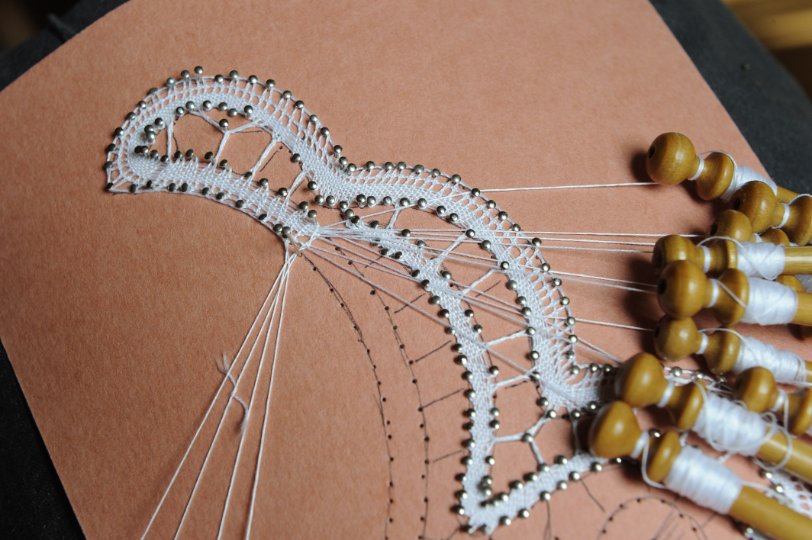
Bobbins: Your Thread Management System
What Does a Bobbin Look Like?
A bobbin is essentially a 4-inch wooden stick with specific parts:
- Head: Top section where thread is secured
- Neck: Narrow area where thread is wound
- Shank: Handle portion you grip
- Spangles (English bobbins only): Beads that add weight and prevent rolling
Types of Bobbins by Region
English/Midlands Bobbins:
- Feature decorative spangles (beads)
- Carved or painted designs
- Work well on flat pillows
- Range: $3-15 each basic, $50+ for antiques
Continental Bobbins:
- Bulbous end for tension control
- No spangles
- Used on bolster pillows
- Typically heavier than English style
Modern Bobbins:
- Machine-made from various woods
- Consistent weight and size
- Most affordable option
- Available in bulk sets
How Do You Wind Bobbins for Bobbin Lace?
- Cut thread twice the length of your finished piece
- Fold in half and tie a slip knot at the center
- Wind one bobbin from each end toward the center
- Leave about 6 inches unwound for working
- Secure thread in the head groove or with a half-hitch
Pillows and Work Surfaces
Cookie Pillows (Flat and Round)
- Best for: Beginners and geometric patterns
- Work style: “Palms down” with bobbins laying flat
- Pros: Affordable, lightweight, good visibility
- Cons: Limited to straight-line work
Bolster Pillows (Cylindrical)
- Best for: Continuous lace and curved patterns
- Work style: “Palms up” with hanging bobbins
- Pros: Can work longer pieces, traditional feel
- Cons: More expensive, requires stand
Block Pillows (Modular)
- Best for: Large projects and professional work
- Work style: Adjustable sections
- Pros: Expandable, professional quality
- Cons: Most expensive option
Pins and Pricking Techniques
Pin Types and Selection
- Lace pins: Fine, sharp points that won’t split threads
- Plastic-head pins: Avoid these – heads can pop off in hard foam
- Corsage pins: Good for holding bobbins out of the way
- Quantity needed: Start with 200+ pins minimum
What Is Pricking?
Pricking refers to the pattern template with holes punched to guide pin placement. Traditional prickings were made by pricking holes through paper with a needle, giving the technique its name.
Thread Selection and Materials
Traditional Materials
- Linen: Historical choice, strong and lustrous
- Cotton: Most popular for beginners (size 10 crochet thread)
- Silk: Luxurious feel, expensive but beautiful results
Modern Options
- Polyester: Durable, consistent, easy to work with
- Metallic threads: For special effects and contemporary designs
- Synthetic blends: Combine properties of different fiber types
Thread Weight Guide
| Thread Size | Best For | Beginner Friendly |
|---|---|---|
| Size 10 | Learning, bookmarks | Yes |
| Size 20 | Fine details, collars | Intermediate |
| Size 30+ | Delicate work, heirloom pieces | Advanced |
Learn more about different cotton fabric types and their properties to understand thread choices better.
Step-by-Step Learning Path
Level 1: Basic Stitches (Week 1-2)
The Two Fundamental Movements
Whole Stitch (Cross-Twist-Cross):
- Cross right pair over left pair
- Twist each pair (right bobbin over left in each pair)
- Cross center threads (left over right)
Half Stitch (Cross-Twist):
- Cross right pair over left pair
- Twist each pair
- No final cross
Your First Project: Simple Braid
- Materials needed: 4 bobbins, pillow, pins
- Time required: 2-3 hours
- Skills learned: Basic movements, pin placement
- Expected outcome: 6-inch decorative braid
Level 2: Ground Patterns (Week 3-4)
Torchon Ground
The most beginner-friendly pattern, creating a diagonal mesh:
- Work in pairs across the width
- Use whole stitch for solid areas
- Use half stitch for open mesh
- Pin at each intersection
Common Beginner Mistakes and Solutions
| Problem | Cause | Solution |
|---|---|---|
| Uneven spacing | Inconsistent tension | Pull threads gently after each stitch |
| Holes too big | Pins too far apart | Follow pattern measurements exactly |
| Threads tangling | Poor bobbin management | Keep pairs organized and separated |
| Pattern distortion | Wrong pin placement | Double-check pattern before pinning |
Level 3: Decorative Elements (Week 5-8)
Spiders (Rose Ground)
A popular decorative element creating flower-like circles:
- Work legs radiating from center
- Use specific sequence for each spoke
- Control spacing with careful pin placement
Picots (Decorative Loops)
Small loops that add texture to lace edges:
- Create extra length in working thread
- Form small loop around pin
- Secure with twist before continuing
Level 4: Complete Projects (Month 2+)
Bookmarks (Most Popular First Project)
- Skills practiced: All basic techniques
- Time investment: 16-20 hours
- Bobbins needed: 12-20 pairs
- Pattern complexity: Beginner to intermediate
Edgings for Linens
- Skills practiced: Corner turning, consistent width
- Time investment: 25-40 hours depending on length
- Applications: Pillowcases, handkerchiefs, table runners
Traditional Styles and Pattern Inspirations
Regional Design Influences
English Styles
Bedfordshire Lace:
- Features cloth stitch flowers
- Uses spangled bobbins
- Popular for collars and cuffs
- Recognizable by thick outlines (gimp threads)
Bucks Point:
- Hexagonal mesh background
- Elegant floral motifs
- Thick gimp threads create contrast
- Set the standard for English lace excellence
Continental European Styles
Flemish Lace:
- Balanced geometric arrangements
- Influenced later Baroque styles
- Dense floral motifs
- Continuous snowflake patterns in Binche style
Milanese Lace:
- Features woven tape construction
- Northern Italian origins
- Distinctive architectural qualities
- Modern versions use color-storing techniques
Traditional Motifs and Their Meanings
Botanical Themes:
- Roses: Symbolized love and beauty
- Oak leaves: Represented strength and endurance
- Ivy: Meant fidelity and eternal life
Architectural Elements:
- Cathedral tracery: Inspired by Gothic windows
- Geometric frames: Reflected Renaissance design
Celestial Patterns:
- Stars: Hope and guidance
- Maltese crosses: Protection and faith
- Sun motifs: Life and prosperity
Iconic Patterns Still Used Today
Four Enduring Design Elements
- Cloth stitch areas for solid, opaque sections
- Open grounds creating transparent backgrounds
- Decorative fillings adding texture and interest
- Gimp outlines defining and emphasizing shapes
Troubleshooting Guide: Common Problems and Solutions
Thread and Tension Issues
Problem: Loops Appearing in Work
Causes:
- Not pulling threads tight enough after each movement
- Bobbins too light (no weight for natural tension)
- Working too fast without checking tension
Solutions:
- Pull gently on all working threads every few stitches
- Add small weights to bobbins or use spangled versions
- Work more slowly, checking tension frequently
- Practice on thicker thread first
Problem: Threads Breaking
Causes:
- Pulling too hard
- Rough bobbin surfaces
- Thread caught on pins or pillow
- Poor quality thread
Solutions:
- Use lighter touch when tensioning
- Sand rough spots on wooden bobbins
- Check pin placement – they shouldn’t catch threads
- Invest in better quality thread
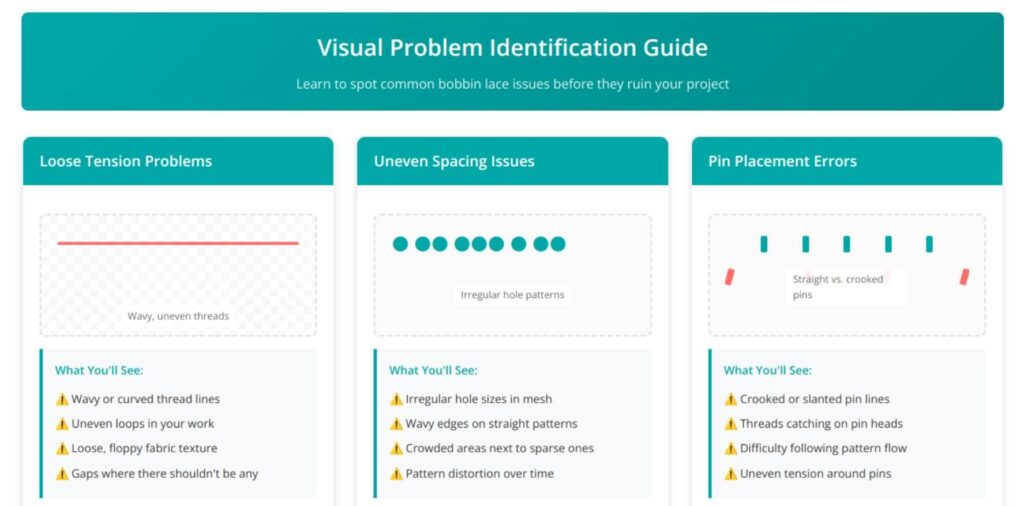

Pattern and Structure Problems
Problem: Uneven Spacing
Visible signs: Irregular holes, wavy edges, distorted patterns Causes:
- Inconsistent pin placement
- Not following pattern measurements
- Rushing through sections
Solutions:
- Use a ruler to check pin spacing regularly
- Mark pattern measurements more clearly
- Work in good lighting with magnification if needed
- Take breaks to maintain concentration
Problem: Wrong Stitch Count
Visible signs: Pattern doesn’t match template, extra or missing elements Causes:
- Losing track of position in pattern
- Mixing up whole stitch and half stitch
- Skipping pattern elements
Solutions:
- Use different colored bobbins for different pattern sections
- Mark your place on the pattern as you work
- Count stitches regularly and compare to pattern
- Keep a notebook of which row you’re working
When to Start Over vs. Continue
Minor Issues You Can Work Around
- Slightly uneven tension (improves with practice)
- Small spacing variations in non-critical areas
- One or two incorrectly placed pins
Problems That Require Starting Over
- Major pattern distortion affecting structure
- Multiple broken threads in central areas
- Fundamental misunderstanding of pattern causing widespread errors
Getting Help
Online Resources
- YouTube tutorials: Search for specific problems
- Facebook groups: “Beginner Bobbin Lacemakers” has regular video meetings
- Forums: Active communities on Reddit and specialized sites
- Video calls: Many experienced lacemakers offer online help
Local Support
- Lace guilds: Found in most major cities
- Community colleges: Sometimes offer continuing education classes
- Craft stores: Staff may know local lacemakers
- Libraries: Often have craft groups or can connect you with local guilds
Contemporary Innovations and Modern Applications
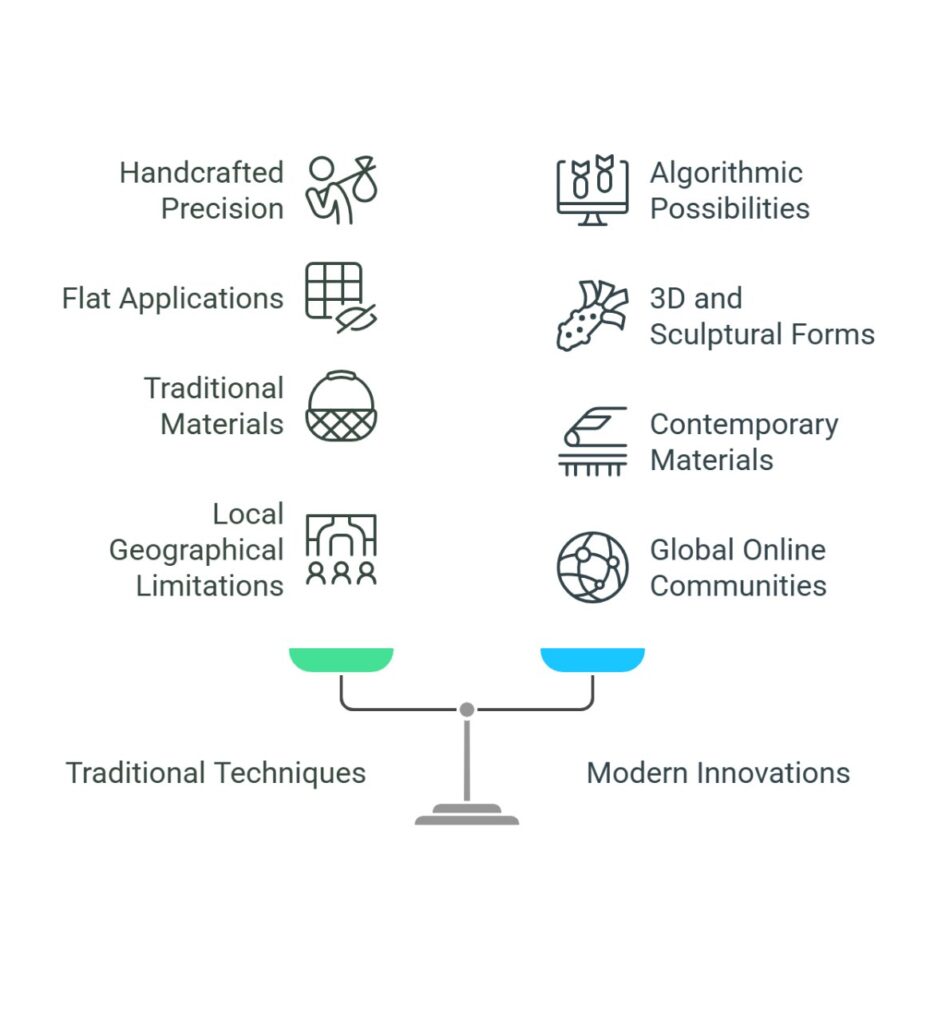
Modern Adaptations and Experimental Approaches
Mathematical Pattern Design
Creative pioneers now blend algorithmic patterns with handcrafted precision. Computer-generated designs create new possibilities that traditional pattern makers never imagined, while still respecting the fundamental stitching techniques.
3D and Sculptural Lace
Modern artists push beyond flat applications:
- 3D Rosalibre technique: Builds layered structures resembling coral reefs
- Free-standing installations: Some pieces stand without support structures
- Architectural applications: Lace-inspired concrete fencing (commercially produced in Bangalore)
- Sound-responsive installations: Using steel threads mixed with traditional materials
Contemporary Material Experiments
Today’s lacemakers experiment with:
- Wire and metallic threads: Creating jewelry and wearable art
- Synthetic fibers: Including glow-in-the-dark threads for special effects
- Mixed media: Combining lace with other textile techniques
- Unconventional scales: From miniature dollhouse applications to room-sized installations
Digital Age Learning and Community
Online Education Revolution
- Virtual workshops: Master lacemakers teach students worldwide
- Pattern sharing platforms: Digital pattern libraries
- Video tutorials: Step-by-step guidance for complex techniques
- Online guilds: Global communities replacing local geographical limitations
Modern Applications Beyond Traditional Use
- Fashion design: Contemporary designers incorporate lace techniques
- Home décor: Modern interpretations for current interior styles
- Art installations: Gallery pieces using traditional techniques
- Therapeutic crafting: Used in art therapy and mindfulness practices
Frequently Asked Questions
Is Bobbin Lace the Same as Tatting?
No, bobbin lace and tatting are completely different techniques. Tatting uses a single thread and shuttle to create a series of knots, while bobbin lace uses multiple threads on bobbins to create a woven fabric. Tatting typically creates smaller, more delicate pieces, while bobbin lace can create larger fabric panels.
What Is the Difference Between Needle Lace and Bobbin Lace?
The fundamental difference lies in construction method:
• Needle lace: Uses a single needle and thread, working with buttonhole stitches over a temporary foundation
• Bobbin lace: Uses multiple threads on bobbins, creating fabric through braiding and twisting
• Appearance: Needle lace often looks more like embroidery, while bobbin lace has a distinctly woven appearance
• Learning curve: Most people find bobbin lace easier to learn initially
Is Bobbin Lace Difficult?
Bobbin lace has a moderate learning curve. The basic movements are simple enough that most people can learn them in a few hours. However, mastering tension control, reading complex patterns, and working with many bobbins simultaneously takes practice. Most beginners can create simple pieces within 2-3 weeks of regular practice.
Can You Cut Bobbin Lace?
Yes, but with important considerations:
• Plan cuts carefully: Cut along natural pattern divisions when possible
• Finish edges: Use tiny stitches to prevent unraveling
• Consider pattern integrity: Some cuts will destroy the structural integrity
• Best practices: Use sharp scissors and work slowly to avoid snags
When Was Bobbin Lace Popular?
Bobbin lace reached peak popularity during:
• 16th-17th centuries: Initial development and spread across Europe
• 18th-19th centuries: Golden age when entire communities depended on lace-making
• Victorian era: High demand for elaborate trims and fashion accessories
• Modern revival: 1970s-present as craft hobby and artistic medium
How Do You Finish a Bobbin Lace?
Finishing techniques depend on the project:
• Secure working threads: Tie off or weave back into existing work
• Remove from pillow: Carefully extract all pins
• Press if needed: Light pressing between damp cloths
• Attach to garment: Sew along edges or use specialized lace application techniques
• Block if necessary: Pin to measurements while damp for proper shape
What Does Bobbin Mean in Textiles?
In textiles, “bobbin” refers to a spool or reel that holds thread or yarn. The term comes from French “bobine.” In bobbin lace, bobbins are specifically designed tools that not only hold thread but also serve as handles for manipulating the threads during the lace-making process.
Can Bobbin Lace Be Made by Machine?
While machines can create lace-like fabrics, true bobbin lace requires hand manipulation of individual threads around pins. Some modern machines can create patterns that look similar to bobbin lace, but they lack the structural characteristics and slight irregularities that make handmade bobbin lace unique and valuable.
What Is the Point of a Bobbin?
Bobbins serve multiple purposes in lace-making:
• Thread storage: Keep threads organized and untangled
• Tension control: Weight of bobbin helps maintain consistent thread tension
• Handle: Provides grip for manipulating threads
• Identification: Different bobbins help track different thread pairs in complex patterns
What Is Bobbin Style?
“Bobbin style” typically refers to the type of bobbins used, which often indicates the regional lace-making tradition:
• English/Midlands style: Uses spangled bobbins with beads
• Continental style: Uses bobbins with bulbous ends for tension
• Modern style: Refers to contemporary bobbin designs and materials
How Is Needle Lace Different from Bobbin Lace?
Key differences include:
| Aspect | Needle Lace | Bobbin Lace |
|---|---|---|
| Tools | Needle and single thread | Multiple bobbins and threads |
| Technique | Buttonhole stitches | Braiding and twisting |
| Foundation | Temporary paper or fabric base | Pins on pillow |
| Appearance | More like embroidery | Distinctly woven texture |
| Learning curve | Steeper initial learning | Easier to start |
Getting Started: Your Action Plan
Week 1: Gather Basic Supplies
Budget Option ($15-30):
- 24 clothes pins from dollar store
- Foam insulation board from hardware store
- 200+ sewing pins
- Size 10 crochet thread in white
Traditional Option ($50-100):
- Beginner bobbin set (24 pieces)
- Cookie pillow or small foam pillow
- Lace pins
- Pattern book with simple designs
Week 2: Learn Basic Movements
- Watch YouTube tutorials: Search “bobbin lace cloth stitch”
- Practice hand movements: Work with 4 bobbins until movements feel natural
- Try simple braid: Create your first piece of lace
- Don’t aim for perfection: Focus on understanding the process
Week 3-4: First Real Project
- Choose a simple bookmark pattern
- Work slowly and carefully
- Expect mistakes: They’re part of learning
- Take breaks: Prevents frustration and maintains quality
Week 5-8: Build Skills and Confidence
- Try different ground patterns
- Learn decorative elements like spiders
- Join online communities for support
- Consider taking a class or workshop
Month 2 and Beyond: Expand Your Horizons
- Work on larger projects
- Experiment with different threads and colors
- Learn regional styles that interest you
- Consider teaching others once you’ve gained confidence
Cultural and Economic Impact
Historical Craftsmanship and Income Generation
By the 17th century, lacemaking emerged as one of the few respectable income sources for women. Widows and unmarried daughters supported entire households through their work. Regional hubs like Flanders and Venice developed distinct styles that commanded premium prices.
The industry’s scale was remarkable. A single Brussels workshop might employ 300 crafters during peak seasons. This decentralized income model empowered rural communities long before factory systems emerged.
Modern Economic Opportunities
Today’s revival of interest in handmade goods creates new opportunities:
- Online marketplaces: Etsy, craft fairs, and custom commissions
- Teaching and workshops: Sharing skills through classes and tutorials
- Pattern design: Creating and selling digital patterns
- Restoration work: Museums and collectors need skilled conservators
Preserving Cultural Heritage
Modern makers serve as cultural custodians, preserving techniques that might otherwise disappear. This work connects contemporary crafters with historical traditions while allowing for creative evolution.
Related Lace Techniques and Comparisons
Bobbin Lace vs. Other Lace Types
When exploring the world of lace, you’ll encounter several different types, each with unique characteristics:
Chantilly Lace: Features delicate floral patterns on fine net background, typically machine-made today
Alençon Lace: Needle lace with raised cord outlines, considered one of the finest lace types
Guipure Lace: Heavy lace without net background, connected by bars or bridges
Corded Lace: Features raised cord elements, can be made with bobbin or needle techniques
Beaded Lace: Incorporates beads or sequins for added texture and sparkle
Understanding Fabric Construction
To better appreciate bobbin lace, it helps to understand how it relates to other fabric types. Unlike woven fabrics that use perpendicular threads, bobbin lace creates structure through diagonal braiding and twisting.
Conclusion
Bobbin lace represents one of humanity’s most enduring and beautiful textile arts. From its origins as a luxury craft in 16th-century Italy to today’s contemporary artistic applications, this technique continues to captivate makers and admirers alike.
What makes bobbin lace special isn’t just its visual beauty, but the meditative process of creation and the deep connection to centuries of tradition. Each piece tells a story – not just through its pattern, but through the hands that shaped every thread.
For beginners, the most important takeaway is that bobbin lace is absolutely learnable at home. While the array of tools and techniques might seem overwhelming initially, remember that every expert started with simple braids and basic movements. The key is patience with yourself and willingness to embrace the learning process.
Investment-wise, bobbin lace offers excellent value. Unlike many hobbies that require constant supply purchases, good tools last decades. Many lacemakers use bobbins passed down through families or acquired second-hand, making this an economically sustainable craft.
Time commitment varies greatly depending on your goals. Simple bookmarks take 15-20 hours for beginners, while complex pieces might require months of work. However, the process itself is deeply satisfying, making time spent a pleasure rather than a chore.
Modern relevance continues to grow as people seek meaningful, handmade alternatives to mass production. Whether you’re drawn to historical reproduction, contemporary art applications, or simply the joy of creating something beautiful with your hands, bobbin lace offers endless possibilities.
Key recommendations for success:
- Start with simple tools and projects
- Connect with online communities for support and inspiration
- Practice basic movements until they become automatic
- Don’t rush – quality develops with time and patience
- Document your journey – you’ll be amazed at your progress
Looking forward, bobbin lace continues evolving as new generations discover this ancient art. Digital pattern sharing, global online communities, and innovative material applications ensure that this traditional craft remains vibrant and relevant.
Whether you create a single bookmark or develop into a master lacemaker, you’re participating in a continuous thread of human creativity that spans over 500 years. In our fast-paced digital world, the slow, deliberate process of bobbin lace offers something irreplaceable: the satisfaction of creating lasting beauty one thread at a time.
The journey from curious beginner to confident lacemaker is filled with small victories, beautiful mistakes, and profound connections to craft traditions. Each twist of thread, each placed pin, each completed section builds not just lace, but skills, patience, and appreciation for the extraordinary artistry possible with the simplest materials.
Start today, start simply, but do start. The world needs more handmade beauty, and bobbin lace offers one of the most rewarding paths to creating it.

